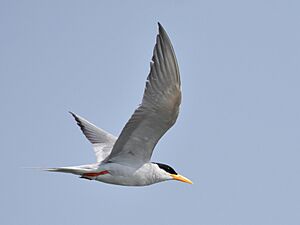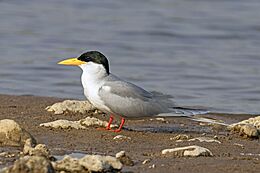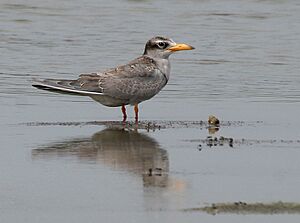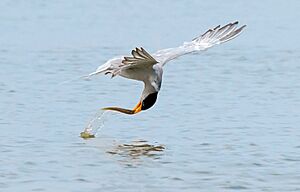River tern facts for kids
Quick facts for kids River tern |
|
|---|---|
|
|
|
| Chambal River, India | |
| Conservation status | |
| Scientific classification | |
| Genus: |
Sterna
|
| Species: |
aurantia
|

The Indian river tern or just river tern (Sterna aurantia) is a type of tern. These birds belong to the family Laridae. They live along rivers in many parts of Asia. You can find them from Iran all the way to Thailand.
Unlike many other terns, the river tern mostly stays near freshwater. They rarely go into salty tidal areas.
Contents
What Does a River Tern Look Like?
The river tern is a medium-sized bird. It is about 38 to 43 centimeters (15 to 17 inches) long. Its upper body is dark grey, and its belly is white. It has a special forked tail with long, flowing feathers. Its wings are long and pointed.
Colors and Changes
The bill (beak) of the river tern is yellow, and its legs are red. When it's time to breed, the bird has a black cap on its head. In winter, this cap turns a greyish-white color. It also gets dark streaks and a dark patch around its eye. The tip of its bill might become darker too.
Both male and female river terns look very similar. Young river terns, called juveniles, look a bit different. They have a brown head and grey upper parts with brown marks. Their sides are grey, and their belly is white. Their bill is yellowish with a dark tip.
Life Cycle and Reproduction
River terns breed between March and May. They gather in groups called colonies to lay their eggs. They choose safe places like sandbanks in rivers.
They make a simple nest on the ground. This nest is often just a scrape in bare rock or sand. The female river tern usually lays three eggs. These eggs can be greenish-grey or buff-colored. They also have brown spots and streaks.
What Do River Terns Eat?
Like other terns, the river tern catches its food by diving into the water. They plunge headfirst to grab their prey. Their diet includes fish, crustaceans (like crabs), tadpoles, and water insects. They hunt in rivers, lakes, and ponds.
Why Are River Terns Disappearing?
The number of river terns is going down. This is mainly because their homes are becoming polluted. Pollution in rivers and lakes makes it harder for them to find food and safe places to live.





